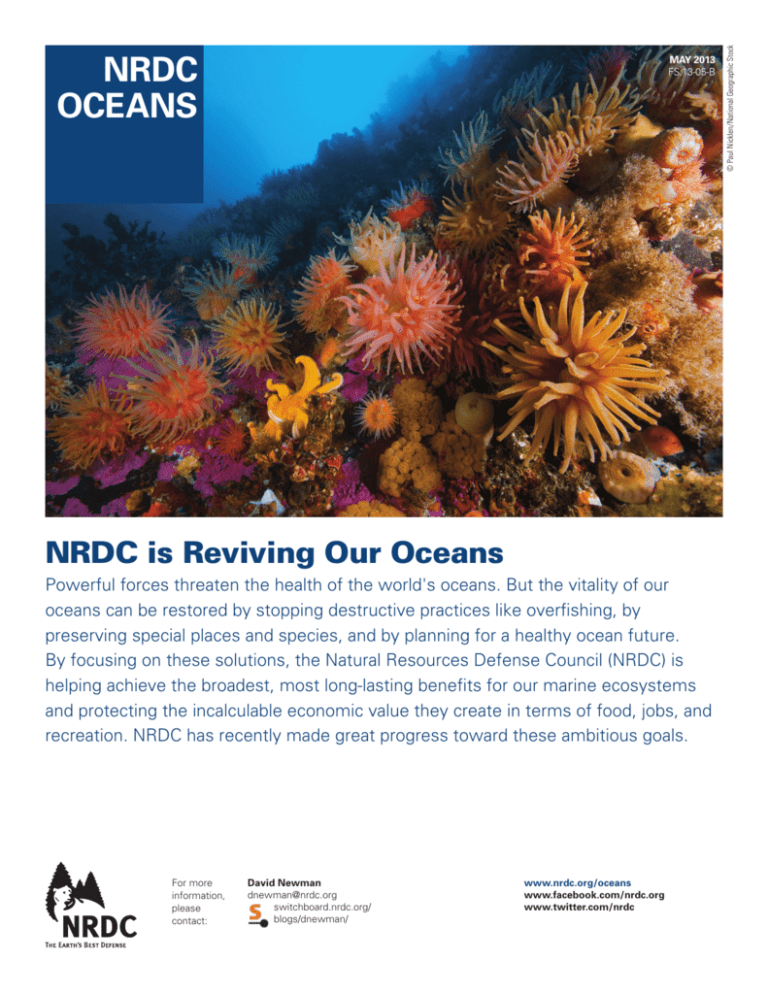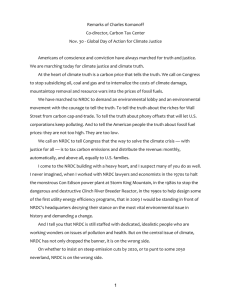Oceans - Natural Resources Defense Council
advertisement

NRDC is Reviving Our Oceans Powerful forces threaten the health of the world's oceans. But the vitality of our oceans can be restored by stopping destructive practices like overfishing, by preserving special places and species, and by planning for a healthy ocean future. By focusing on these solutions, the Natural Resources Defense Council (NRDC) is helping achieve the broadest, most long-lasting benefits for our marine ecosystems and protecting the incalculable economic value they create in terms of food, jobs, and recreation. NRDC has recently made great progress toward these ambitious goals. For more information, please contact: David Newman dnewman@nrdc.org switchboard.nrdc.org/ blogs/dnewman/ www.nrdc.org/oceans www.facebook.com/nrdc.org www.twitter.com/nrdc © Paul Nicklen/National Geographic Stock NRDC Oceans May 2013 FS:13-05-B Bringing Back the Fish © David Doubilet For 15 years, NRDC has worked to end overfishing and to rebuild U.S. ocean fish populations. This work is paying off. Many U.S. fish populations are now showing robust signs of recovery and the United States has become a model for sustainable fisheries management globally. According to NRDC’s Bringing Back the Fish report, nearly two-thirds of once-overfished, federally managed ocean fish stocks have been rebuilt or made significant progress in being rebuilt. Gross commercial revenues for the rebuilt and rebuilding stocks are up 92 percent (54 percent when adjusted for inflation) from before rebuilding. NRDC’s litigation and advocacy have contributed to this recovery. NRDC is also working to protect important marine species, such as the great hammerhead shark and Atlantic sturgeon, which are under threat of extinction. Preserving the “Yosemites of the Sea” NRDC has been a leader in the establishment of a statewide network of safe havens for ocean wildlife along the California coast. The network, which extends from the Oregon border to Mexico, protects biological gems comprising 16 percent of California’s coastal waters. NRDC played an instrumental role in enacting the law that called for creation of this network and has worked since 1999 with local residents, divers, business owners, fishermen, scientists, and conservationists to design and implement the network. © Paul Nicklen/ National Geographic Stock Off the Atlantic coast, NRDC is fighting to protect a chain of undersea canyons and seamounts that run between 75 miles and 100 miles offshore from Cape Hatteras to southeast of Cape Cod. These ocean features are home to rare deep sea coral communities and serve as key spawning and feeding grounds for a myriad of sea creatures, including important fish species, endangered whales, and other marine mammals. NRDC is also working at the United Nations to create a mechanism to establish protected zones for marine wildlife on the high seas, the area beyond any one country’s jurisdiction. Protecting the Arctic Ocean NRDC is working both domestically and internationally to protect the Arctic Ocean. In May 2013, the foreign ministers of the eight countries that form the Arctic Council are expected to endorse international action to promote integrated, ecosystem-based management. NRDC participated in the development of the recommendations, which, if successful, could significantly advance conservation of the Arctic marine environment. Our next goal is to establish an international network of marine protected areas in the Arctic Ocean. In the U.S. Arctic Ocean, NRDC is advocating for a moratorium on further drilling approvals that will ensure the protection of vulnerable Arctic ecosystems and wildlife. Promoting Smart Ocean Planning NRDC has long advocated for the adoption of a national ocean policy to protect our oceans and coasts, and the communities and economies they support. In July 2010, President Obama issued Executive Order 13547, establishing the first-ever National Ocean Policy which calls on federal agencies to protect the health and biodiversity of ocean and coastal ecosystems and resources. This policy will help ensure that all government agencies with a hand in ocean activities work together for improved ocean health and that all of us who love and use our oceans have a say in their management, through the development and implementation of regional ocean plans. At the national and regional levels, NRDC is advancing the national policy and promoting smart ocean planning. © Alex Mustard Understanding How Ocean Acidification Affects Human Communities On average, the world’s ocean chemistry is shifting faster than it has in millions of years as a result of rising fossil fuel emissions. But global changes do not capture what is happening in local “hotspots,” where acidity is rising more quickly than expected from a mix of local factors, placing marine life in imminent danger. Shellfish fisheries and coral reefs are at particular risk. NRDC is identifying those human communities in the United States and around the world that most depend on these vulnerable resources. In addition, we are urging Congress to support fully the creation of a national ocean acidification research and monitoring network to arm these vulnerable communities with the information they need to reduce harm now and prevent it in the future. Stemming Ocean Noise Pollution NRDC leads the international environmental community in controlling underwater noise, a major source of marine pollution that dramatically undermines the ability of whales, dolphins, fish, and other species to survive and reproduce. Through litigation, we have compelled the U.S. Navy to avoid important habitat—off the U.S. coast and around the world—when training with dangerous sonar systems, and we have kept high-intensity oil and gas exploration out of vital whale and dolphin habitat in the Gulf of Mexico. Through partnering with the U.S. government and industry, we have put ocean noise on the agenda at the International Maritime Organization, which is now developing guidelines to curb noise from large commercial ships. We have also collaborated with offshore wind developers on mitigation measures to protect endangered North Atlantic right whales. Stopping Marine Plastic Pollution at its Source NRDC is working in a number of ways to protect our oceans from marine plastic pollution. We used the United Nations Conference on Sustainability in Rio to educate policymakers from around the world about the problem of marine debris and about effective solutions. The final agreement produced by the delegates featured a commitment to take action to reduce marine pollution, especially plastics, from landbased sources. In the United States, we are building support for legislation to control some of the most problematic forms of plastic waste (e.g., single-use plastics). In 2012, NRDC and our clean seas partners won a major victory in California when Los Angeles became the largest city in the United States to ban plastic bags at supermarket checkout lines. We are now leading an effort to advance legislation to transfer the financial burden of managing the waste found as marine debris from local government and taxpayers to the producers, thus advancing source-reduction and recycling. This type of approach, known as Extended Producer Responsibility (EPR), has been applied in many states for difficult-to-dispose of materials, such as paint and carpet, and can be used to tackle pollution at its source. Three Ways YOU Can Promote Sustainable Fisheries and Healthy Oceans 1. Eat Sustainable Seafood n B uy Locally Caught Seafood—The More Local, the Better: U.S. fish stocks are now some of the best managed in the world with populations rebounding because of tough conservation requirements. n U se the Monterey Bay Aquarium’s Seafood Watch App to choose sustainable options. n E at Lower Down on the Food Chain: The larger fish species are often overfished and also may contain the most toxins, so eat fish further down the food chain like mackerel, sardines, squid, and shellfish. n B uy Wild: Given current issues with the environmental impacts of fish farming, a wildcaught fish is usually better for your health and the environment. n J oin a Community-Supported Fishery (CSF): Similar to a local farm share—or community supported agriculture (CSA)—the CSF allows you to connect directly with local fishermen, ensuring super fresh, local seafood. Many CSFs also abide by specific sustainability criteria, ensuring the fish being served is abundant and the method of capture is not causing ecological harm. Examples of CSFs in New York City include Iliamna Fish Co. (www.redsalmon.com); Mermaid’s Garden (www.mermaidsgardennyc.com); and Village Fishmonger (www.villagefishmongernyc.com). 2.Tell Congress to Support Strong Ocean Conservation, Such As: n T he conservation requirements of the Magnuson-Stevens Fishery Conservation and Management Act to prevent overfishing and rebuild overfished species n T he National Oceans Policy for smart coordination of oceans uses and protection of overall ocean health n I ncreased funding for research, monitoring, and preparedness for ocean acidification n P rotection of the Arctic 3. S upport NRDC’s Ocean Work www.nrdc.org/oceans Printed on recycled paper © May 2013 Natural Resources Defense Council www.nrdc.org/oceans







